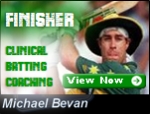|
 This is a guest post on batting skills from Laurie Ward of the Complete Cricketer Academy. This is a guest post on batting skills from Laurie Ward of the Complete Cricketer Academy.
If you were offered the wisdom of Sunil Gavaskar, Ricky Ponting and Brian Lara, I am guessing that you might be interested?
These gems are extremely simple and have been the cornerstone of our batting coaching at The Complete Cricketer Academy, with unbelievable results and a better understanding and "feel" for the players.
The Invisible Wall
Sunil Gavaskar had to open the batting against some of the most deadly bowlers in history, before the advent of proper helmets. He would often have to face the likes of Michael Holding or Andy Roberts on bouncy, fast tracks with only a floppy hat to protect him from the harsh West Indian sun.
The Indian opener came up with an amazingly simple solution to help him stay still and give himself the best chance to see the ball on release from the hand.
He would find a straight, smooth wall in the changing room and set himself up with his cheek touching the cool wall. When in the middle, he would imagine this wall against his face and make a sub-conscious effort to not move his head until the ball had been released.
Ricky Ponting used the visor of his helmet to try to keep his eyes level before delivery. Add this to the invisible wall and we create an invisible right angle to keep the head still and level.
In our High Performance Centre, we have a bowling machine net with a protective net in front of the feeder. With this, we can line up a player's off side cheek with a line on the net. This can be done after a trigger, and before release of a delivery.
Another way to do this is to gauge against the back net or put lines behind the batter for reference.
When a player trusts and feels the stillness on release the results and belief are incredible: The players make better, later decisions, creating later, more positive movements and therefore a later contact, closer to the line of the eyes.
We can track this on camera and give the player immediate visual feedback, comparing when they are still on release compared to a movement as the ball is released.
This leads into the second "invisible".
The Invisible Box
This concept helps a player to feel where ball strike takes place, and the difference between partial contact and hitting the sweet spot. We are trying to get the player to feel where the optimum "strike zone" is for each delivery type.
If you have played Wii Golf or a computer game that requires power and timing, there is often a power bar with a line moving up for you to stop for optimum control and power.
This represents the invisible box in batting.
If you hit too early or too late on Wii Golf you can see the effects and actually feel the remote buzzing in your hand. It is the same with striking a cricket ball. We get our batters to start with an imaginary box the size of a shoebox say, and try to let the ball "come into the box".
Depending on which shot is being played, the box is in a different place, but will remain close to the line of the eyes.
On a front foot drive, the box is under the eyes and close to the front pad. If the batter strikes too early, outside the box, they will tend to toe-end the ball more than hit the middle of the bat. This also increases risk and reduces power. Once a player strikes a ball in the box they can feel that less force is required due to the timing. Once they trust and buy in to this concept they make dramatic strides to playing tighter, yet increasing power and control through timing.
Brian Lara's main tip for batting, when prompted by former team mate Andy Moles, was to watch the ball on to and off the bat. This, in reality, is not feasible, but it does tie in perfectly with the Invisible Box and playing the ball in line with or under the eyes.
The beauty of these thoughts and mental imagery are that they are so simple, yet so powerful.
Once a player is absolutely still, but poised and balanced, at the exact release of the ball, it allows his eyes to feed clearer information for the brain to read and use in decision making. This increases the amount of time a player feels he has. He can use this additional time to make more positive, later movements, which in turn add cleaner momentum to the body and foot movements and bat presentation.
The later movements then allow later contact and therefore increased power in attack or control in defence.
All of the greats of batting have seemed to have more time than us mere mortals. It is not superior eyesight, Hashim Amla springs to mind, but getting these simple and effective skills honed and believing in them.
Click here to find out more about the Complete Cricketer Academy, a PitchVision venue.
Discuss this article with other subscribers
|

.jpg)



.jpg)

